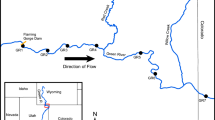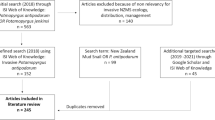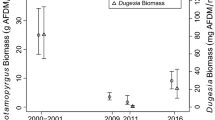Abstract
Boom-bust dynamics of invasive species have long intrigued scientists and managers alike, but quantification of such dynamics, let alone their causes, is rare. We documented the decline of a previously prolific invasive mudsnail, Batillaria attramentaria, at Elkhorn Slough estuary in central California, USA. The mudsnail was the most abundant epibenthic invertebrate in the estuary, maintaining very high densities for many decades before declining heterogeneously throughout the estuary over the past decade, decreasing in density by three orders of magnitude at some sites. We used field and laboratory experiments to test several possible mechanisms for its demise. We show that the crab Pachygrapsus crassipes can prey heavily on Batillaria. We detected high dissolution rates of Batillaria shells, and we measured greater predation rates on tethered snails with dissolved versus intact shells. Warm water temperatures and high water levels coincided with the period of most dramatic Batillaria declines (2013–2015). Localized water impoundments appear to buffer environmental drivers of the decline because Batillaria remained abundant at sites with artificial tidal restriction, while the population crashed at one site after full tidal exchange was restored. We also investigated trematode parasite prevalence and molluscicide applications to the surrounding watershed as possible causes of mudsnail declines, but they had little explanatory power. Our findings illustrate the potential for population crashes even for long-established introduced species at pest levels of abundance, and demonstrate that such declines can exhibit spatial heterogeneity. Both of these results highlight the value of investigating population dynamics of invaders across multiple temporal and spatial scales.








Similar content being viewed by others
References
Aagaard K, Lockwood JL (2016) Severe and rapid population declines in exotic birds. Biol Invasions 18(6):1667–1678
Aghighi S, Fontanini L, Yeoh PB, Hardy GSJ, Burgess TI, Scott JK (2014) A conceptual model to describe the decline of European blackberry (Rubus anglocandicans), a weed of national significance in Australia. Plant Dis 98(5):580–589
Angelini C, van der Heide T, Griffin JN, Morton JP, Derksen-Hooijberg M, Lamers LP, Silliman BR (2015) Foundation species’ overlap enhances biodiversity and multifunctionality from the patch to landscape scale in southeastern United States salt marshes. Proc R Soc B Biol Sci 282(1811):20150421
Armitage AR, Fong P (2006) Predation and physical disturbance by crabs reduce the relative impacts of nutrients in a tidal mudflat. Mar Ecol Prog Ser 313:205–213
Asfaw A, Maher K, Shucksmith JD (2018) Modelling of metaldehyde concentrations in surface waters: a travel time based approach. J Hydrol 562:397–410
Bonnot P (1935) A recent introduction of exotic species of molluscs into California waters from Japan. Naut 49(1):1–2
Buchsbaum RN, Catena J, Hutchins E, James-Pirri MJ (2006) Changes in salt marsh vegetation, Phragmites australis, and nekton in response to increased tidal flushing in a New England salt marsh. Wetlands 26(2):544–557
Busch DS, Maher M, Thibodeau P, McElhany P (2014) Shell condition and survival of Puget Sound pteropods are impaired by ocean acidification conditions. PLoS ONE 9(8):e105884
Byers JE (1999) The distribution of an introduced mollusc and its role in the long-term demise of a native confamilial species. Biol Invasions 1(4):339–353
Byers JE (2000a) Competition between two estuarine snails: implications for invasions of exotic species. Ecology 81(5):1225–1239
Byers JE (2000b) Differential susceptibility to hypoxia aids estuarine invasion. Mar Ecol Prog Ser 203:123–132
Byers JE (2002) Impact of non-indigenous species on natives enhanced by anthropogenic alteration of selection regimes. Oikos 97(3):449–458
Byers JE, Goldwasser L (2001) Exposing the mechanism and timing of impact of non-indigenous species on native species. Ecology 82(5):1330–1343
Caffrey JM, Brown M, Tyler WB, Silberstein M (eds) (2002) Changes in a California estuary: a profile of Elkhorn Slough. Elkhorn Slough Foundation, Moss Landing, p 280
Cai W-J, Chen F, Powell EN, Walker SE, Parsons-Hubbard KM, Staff G, Ashton-Alcox KA, Callender WR, Brett CE (2006) Preferential dissolution of carbonate shells driven by petroleum seep activity in the Gulf of Mexico. Earth Planet Sci Lett 248:212–228
Carlton JT (1992) Introduced marine and estuarine mollusks of North America: an end-of-the-20th-century perspective. J Shellfish Res 11(2):489–505
Castle GD, Mills GA, Gravell A, Jones L, Townsend I, Cameron DG, Fones GR (2017) Review of the molluscicide metaldehyde in the environment. Environ Sci Water Res Technol 3(3):415–428
Cooling M, Hoffmann BD (2015) Here today, gone tomorrow: declines and local extinctions of invasive ant populations in the absence of intervention. Biol Invasions 17(12):3351–3357
Crooks JA, Talley DM, Crodrey M, Whitcraft C, Lorda-Solorzano J, Uyeda K, Bellringer H, McCullough J, Akmeida M (2016) Unnatural history: biological invasions into coastal ecosystems. U.S-Iran Symposium on Wetlands, Irvine, CA, 28–30 March 2016
Diez JM, Dickie I, Edwards G, Hulme PE, Sullivan JJ, Duncan RP (2010) Negative soil feedbacks accumulate over time for non-native plant species. Ecol Lett 13:803–809
Doak DF, Estes JA, Halpern BS, Jacob U, Lindberg DR, Lovvorn J, Monson DH, Tinker MT, Williams TM, Wootton JT, Carroll I (2008) Understanding and predicting ecological dynamics: are major surprises inevitable. Ecology 89(4):952–961
Doney SC, Fabry VJ, Feely RA, Kleypas JA (2009) Ocean acidification: the other CO2 problem. Annu Rev Mar Sci 1:169–192
Elton CS (1958) The ecology of invasions by plants and animals. Methuen, London
Fabian RA (2016) Ecological effects of an invasive mud snail and its body-snatching parasites: implications for organic matter cycling in a eutrophic estuary (Doctoral dissertation, UC Santa Cruz)
Grason EW, McDonald PS, Ruesink JL (2018) Comparing residence time and natural enemies between low-and high-density invasions. Biol Invasions 20(11):3315–3330
Hasegawa K (2000) Batillariidae. In: Okutani T (ed) Marine mollusks in Japan. Tokai University Press, Tokyo, pp 130–133
Hechinger RF (2007) Annotated key to the trematode species infecting Batillaria attramentaria (Prosobranchia: Batillariidae) as first intermediate host. Parasitol Int 56(4):287–296
Hechinger RF (2010) Mortality affects adaptive allocation to growth and reproduction: field evidence from a guild of body snatchers. BMC Evol Biol 10(1):136
Hellmann JJ, Byers JE, Bierwagen BG, Dukes JS (2008) Five potential consequences of climate change for invasive species. Conserv Biol 22(3):534–543
Hughes BB, Haskins JC, Wasson K, Watson E (2011) Identifying factors that influence expression of eutrophication in a central California estuary. Mar Ecol Prog Ser 439:31–43
Keane RM, Crawley MJ (2002) Exotic plant invasions and the enemy release hypothesis. Trends Ecol Evol 17(4):164–170
Kennish MJ (2002) Environmental threats and environmental future of estuaries. Environ Conserv 29(1):78–107
Lorda J, Hechinger RF, Cooper SD, Kuris AM, Lafferty KD (2016) Intraguild predation by shore crabs affects mortality, behavior, growth, and densities of California horn snails. Ecosphere 7(5):e01262
May RM, Conway GR, Hassell MP, Southwood TRE (1974) Time delays, density-dependence and single-species oscillations. J Anim Ecol 43:747–770
McLean JH (1960) Batillaria cumingi, introduced cerithid in Elkhorn Slough. Veliger 2(3):61–63
Miura O, Torchin ME, Kuris AM, Hechinger RF, Chiba S (2006) Introduced cryptic species of parasites exhibit different invasion pathways. Proc Natl Acad Sci 103(52):19818–19823
Miura O, Sasaki Y, Chiba S (2012) Destruction of populations of Batillaria attramentaria (Caenogastropoda: Batillariidae) by tsunami waves of the 2011 Tohoku earthquake. J Molluscan Stud 78(4):377–380
Moreau P, Burgeot T, Renault T (2015) In vivo effects of metaldehyde on Pacific oyster, Crassostrea gigas: comparing hemocyte parameters in two oyster families. Environ Sci Pollut Res 22(11):8003–8009
Örstan A (2006) Antipredatory function of the retractibility of Batillaria minima into its shell. Triton 14:1–2
Parker IM, Simberloff D, Lonsdale WM, Goodell K, Wonham M, Kareiva PM, Williamson MH, Von Holle BMPB, Moyle PB, Byers JE, Goldwasser L (1999) Impact: toward a framework for understanding the ecological effects of invaders. Biol Invasions 1(1):3–19
Peery MZ, Beissinger SR, Newman SH, Burkett EB, Williams TD (2004) Applying the declining population paradigm: diagnosing causes of poor reproduction in the marbled murrelet. Conserv Biol 18(4):1088–1098
Peterson W, Robert M, Bond N (2015) The warm blob continues to dominate the ecosystem of the northern California current. PICES Press 23(2):44
Powell EN, Staff GM, Callender WR, Ashton-Alcox KA, Brett CE, Parsons-Hubbard KM, Walker SE, Raymond A (2011) Taphonomic degradation of molluscan remains during thirteen years on the continental shelf and slope of the northwestern Gulf of Mexico. Palaeogeogr Palaeoclimatol Palaeoecol 312:209–232
Prozorova LA, Volvenko IE, Noseworthy R (2012) Distribution and ecological morphs of northwestern Pacific gastropod Batillaria attramentaria (G.B. Sowerby II, 1855)(Caenogastropoda: Batillariidae). In: Proceedings of the Russia–China bilateral symposium on marine ecosystems under change in the Northwestern Pacific, Vladivostok, Russia. October 8–9, 2012, p 157
R Core Team (2018) R: a language and environment for statistical computing. R Foundation for Statistical Computing, Vienna, Austria. https://www.R-project.org/
Raposa KB, Roman CT (2003) Using gradients in tidal restriction to evaluate nekton community responses to salt marsh restoration. Estuaries 26(1):98–105
Ritter AF, Wasson K, Lonhart SI, Preisler RK, Woolfolk A, Griffith KA, Heiman KW (2008) Ecological signatures of anthropogenically altered tidal exchange in estuarine ecosystems. Estuaries Coasts 31(3):554
Robbins LL, Hansen ME, Kleypas JA, Meylan SC (2010) CO2calc—a user-friendly seawater carbon calculator for Windows, Max OS X, and iOS (iPhone): U.S. Geological Survey Open-File Report 2010–1280, p 17
Sakai AK, Allendorf FW, Holt JS, Lodge DM, Molofsky J, With KA, Baughman S, Cabin RJ, Cohen JE, Ellstrand NC, McCauley DE (2001) The population biology of invasive species. Annu Rev Ecol Syst 32(1):305–332
Sato SI, Chiba T (2016) Structural changes in molluscan community over a 15-year period before and after the 2011 Great East Japan earthquake and subsequent Tsunami around Matsushima Bay, Miyagi Prefecture, Northeastern Japan. PLoS ONE 11(12):e0168206
Simberloff D, Gibbons L (2004) Now you see them, now you don’t!—population crashes of established introduced species. Biol Invasions 6:161–172
Sousa W (1993) Size-dependent predation on the salt-marsh snail Cerithidea californica Haldeman. J Exp Mar Biol Ecol 166(1):19–37
Strayer DL, Eviner VT, Jeschke JM, Pace ML (2006) Understanding the long-term effects of species invasions. Trends Ecol Evol 21:645–651
Strayer DL, D’Antonio CM, Essl F, Fowler MS, Geist J, Hilt S, Jarić I, Jöhnk K, Jones CG, Lambin X, Latzka AW (2017) Boom-bust dynamics in biological invasions: towards an improved application of the concept. Ecol Lett 20(10):1337–1350
Strickler KB, Harmon PF, Goss EM, Clay K, Flory SL (2016) Emergence and accumulation of novel pathogens suppress an invasive species. Ecol Lett 19:469–478
Torchin ME, Byers JE, Huspeni TC (2005) Differential parasitism of native and introduced snails: replacement of a parasite fauna. Biol Invasions 7(6):885–894
Van Dyke E, Wasson K (2005) Historical ecology of a central California estuary: 150 years of habitat change. Estuaries 28(2):173–189
Vermeij GJ (1982) Environmental change and the evolutionary history of the periwinkle (Littorina littorea) in North America. Evolution 36(3):561–580
Walker SE (2001) Paleoecology of gastropods preserved in turbiditic slope deposits from the upper Pliocene of Ecuador. Palaeogeogr Palaeoclimatol Palaeoecol 166:141–163
Walker SE, Parsons-Hubbard K, Powell E, Brett C (2002) Predation on experimentally-deployed molluscan shells from shelf-to-slope depths in a tropical carbonate environment. Palaios 17:151–169
Wasson K, Zabin CJ, Bedinger L, Diaz MC, Pearse JS (2001) Biological invasions of estuaries without international shipping: the importance of intraregional transport. Biol Cons 102(2):143–153
Wasson K, Fenn K, Pearse JS (2005) Habitat differences in marine invasions of central California. Biol Invasions 7(6):935–948
Wasson K, Raposa K, Almeida M, Beheshti K, Crooks JA, Deck A, Dix N, Garvey C, Goldstein J, Johnson DS, Lerberg S (2019) Pattern and scale: evaluating generalities in crab distributions and marsh dynamics from small plots to a national scale. Ecology. https://doi.org/10.1002/ecy.2813
Weiskel HW (2012) The interaction of nutrient loading and biological invasions in a benthic estuarine community. PhD dissertation, University of California, Davis. https://pqdtopen.proquest.com/doc/1318635431.html?FMT=ABS. Accessed 15 Feb 2019
Weiskel H, Byers J, Huspeni T, Zabin C, Mohammad B, Grosholz E (2007) New lessons from an old invader: the effects of an invasive mud snail on ecosystem function in northern California. Ecological Society of America Annual Meeting. August 2007
Whitlatch RB (1974) Studies on the population ecology of saltmarsh gastropods, Batillaria zonalis. Veliger 17:47–55
Whitlatch RB, Obrebski S (1980) Feeding selectivity and coexistence in two deposit-feeding gastropods. Mar Biol 58(3):219–225
Williams PB, Orr MK (2002) Physical evolution of restored breached levee salt marshes in the San Francisco Bay estuary. Restor Ecol 10(3):527–542
Williamson M (1996) Biological invasions, vol 15. Springer, Berlin
Wonham MJ, O’Connor M, Harley CD (2005) Positive effects of a dominant invader on introduced and native mudflat species. Mar Ecol Prog Ser 289:109–116
Yamada SB (1982) Growth and longevity of the mud snail Batillaria attramentaria. Mar Biol 67(2):187–192
Yamada SB, Boulding EG (1998) Claw morphology, prey size selection and foraging efficiency in generalist and specialist shell-breaking crabs. J Exp Mar Biol Ecol 220(2):191–211
Acknowledgements
We appreciate field assistance from many students, staff and volunteers over the years, including Lucas Principe, Olivia Arredondo, Lindsay Gaskins, Kathleen Hicks and the Research Experience for Undergraduates program at CSUMB, supported by NSF REU BIO-OCE awards 1359488 and 1659628. Thanks to Andrew DeVogelaere, Steve Lonhart, and Erica Burton for their long-term support for the bank erosion monitoring program which supplied some of the snail and crab data. Thanks to Kelly Goedde-Matthews, Kristy Kroeker and the UCSC Coastal Sustainability Lab for pore water analysis. Elkhorn Slough Reserve staff (KW, SF, RJ, CE) were supported by grants from NOAA’s Office for Coastal Management. We are grateful to Jim Carlton and three anonymous reviewers who provided extensive, thoughtful suggestions that improved the clarity of the paper.
Author information
Authors and Affiliations
Corresponding author
Additional information
Publisher's Note
Springer Nature remains neutral with regard to jurisdictional claims in published maps and institutional affiliations.
Electronic supplementary material
Below is the link to the electronic supplementary material.
Rights and permissions
About this article
Cite this article
Wasson, K., Fabian, R.A., Fork, S. et al. Multiple factors contribute to the spatially variable and dramatic decline of an invasive snail in an estuary where it was long-established and phenomenally abundant. Biol Invasions 22, 1181–1202 (2020). https://doi.org/10.1007/s10530-019-02172-w
Received:
Accepted:
Published:
Issue Date:
DOI: https://doi.org/10.1007/s10530-019-02172-w




